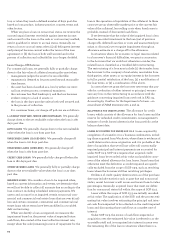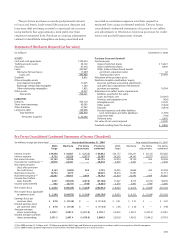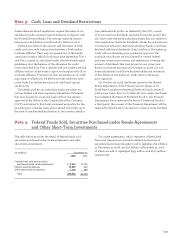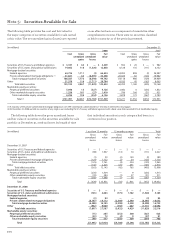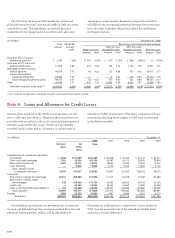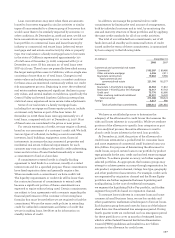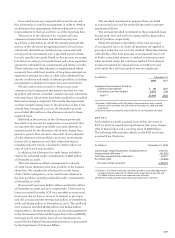Wells Fargo 2008 Annual Report Download - page 107
Download and view the complete annual report
Please find page 107 of the 2008 Wells Fargo annual report below. You can navigate through the pages in the report by either clicking on the pages listed below, or by using the keyword search tool below to find specific information within the annual report.
The unrealized losses associated with debt securities that
had been in a continuous loss position for 12 months or more
at December 31, 2008, were primarily due to extraordinarily
wide asset spreads for residential mortgage, commercial
mortgage and commercial loan asset-backed securities
resulting from an illiquid market, which caused these assets
to be valued at significant discounts to their acquisition cost.
At December 31, 2008, we believed that it is probable that
we will be able to collect all contractually due principal and
interest on these securities. We evaluate these securities for
impairment in accordance with our policies on a quarterly
basis or more frequently if a loss-triggering event occurs.
This evaluation includes evaluating whether there have been
any changes in security ratings issued by ratings agencies,
performance of the underlying collateral for asset-backed
securities including delinquency rates, cumulative losses
to date, and the remaining credit enhancement as
compared to expected credit losses of the security.
The unrealized losses associated with private collateralized
mortgage obligations related to securities backed by commercial
mortgages and residential mortgages. Approximately 75%
of the securities were AAA-rated by at least one major rating
agency. We estimate loss projections for each security by
assessing individual loans collateralizing the security and
determining expected default rates and loss severities. In
addition, based upon our assessment of expected credit losses
of the security given the performance of the underlying
collateral compared to our credit enhancement, we concluded
that these securities were not other-than-temporarily
impaired at December 31, 2008.
The unrealized losses associated with other securities
related to securities backed by commercial loans and individual
issuer companies. For securities with commercial loans as the
underlying collateral, we have evaluated the expected credit
losses in the security and concluded that we have sufficient
credit enhancement when compared with our estimate of
credit losses for the individual security. For individual issuers,
we evaluate the financial performance of the issuer on a
quarterly basis to determine if it is probable that the issuer
can make all contractual principal and interest payments.
The unrealized losses associated with securities of U.S.
states and political subdivisions are primarily driven by
changes in interest rates and not due to the credit quality
of the securities. These investments are almost exclusively
investment grade and were generally underwritten in
accordance with our own investment standards prior to
the determination to purchase, without relying on a bond
insurer’s guarantee in making the investment decision.
These securities will continue to be monitored as part of our
on-going impairment analysis, but are expected to perform,
even if the rating agencies reduce the credit rating of the bond
insurers. As a result, we concluded that these securities were
not other-than-temporarily impaired at December 31, 2008.
Because we have the ability and intent to hold these debt
securities until a recovery of fair value, which may be maturity,
we do not consider these investments to be other-than-
temporarily impaired at December 31, 2008.
Our marketable equity securities included approximately
$4.7 billion of investments in perpetual preferred securities
at December 31, 2008. These securities provide very attractive
tax-equivalent yields and were current as to periodic
distributions in accordance with their respective terms as
of December 31, 2008. We have opportunistically increased
our holdings in these securities over the past 18 months in
response to increased yields available in the marketplace,
driven by a significant widening in credit spreads caused
by the mortgage and credit crises. The market value of our
holdings in these securities declined during this period as
a result of the continued widening of credit spreads. We
evaluated these hybrid financial instruments for impairment
using an evaluation methodology similar to that used for debt
securities. Perpetual preferred securities were not other-than-
temporarily impaired at December 31, 2008, if there was no
evidence of credit deterioration or investment rating down-
grades of any issuers to below investment grade, and it was
probable we would continue to receive full contractual pay-
ments. We will continue to evaluate the prospects for these
securities for recovery in their market value in accordance
with our policy for determining other-than-temporary
impairment. We have recorded impairment write-downs
on perpetual preferred securities where there was evidence
of credit deterioration.
The fair values of our investment securities could decline
in the future if the underlying performance of the collateral
for the private collateralized mortgage obligations or other
securities deteriorate and our credit enhancement levels do
not provide sufficient protection to our contractual principal
and interest. As a result, there is a risk that significant other-
than-temporary impairments may occur in the future given
the current economic environment.
Securities pledged where the secured party has the right to
sell or repledge totaled $10.1 billion at December 31, 2008, and
$5.8 billion at December 31, 2007. Securities pledged where
the secured party does not have the right to sell or repledge
totaled $71.6 billion at December 31, 2008, and $44.9 billion at
December 31, 2007, primarily to secure trust and public deposits
and for other purposes as required or permitted by law.
The following table shows the net realized gains on
the sales of securities from the securities available-for-sale
portfolio, including marketable equity securities. Gross
realized losses included other-than-temporary impairment
of $1,790 million, $50 million and $22 million for 2008, 2007
and 2006, respectively. Other-than-temporary impairment
for 2008 included $1,057 million related to perpetual preferred
securities that were either downgraded to less than investment
grade or evidenced other significant credit deterioration events.
(in millions) Year ended December 31,
2008 2007 2006
Gross realized gains $ 1,918 $ 472 $ 621
Gross realized losses (1,883) (127) (295)
Net realized gains $35 $ 345 $ 326



